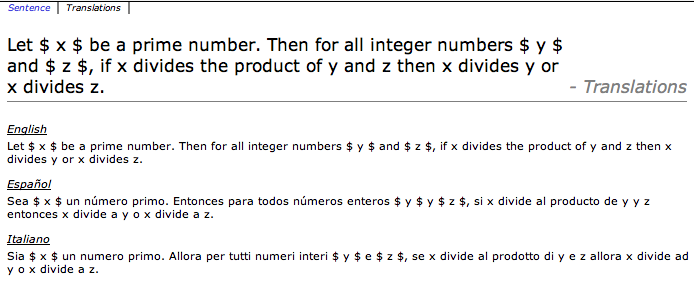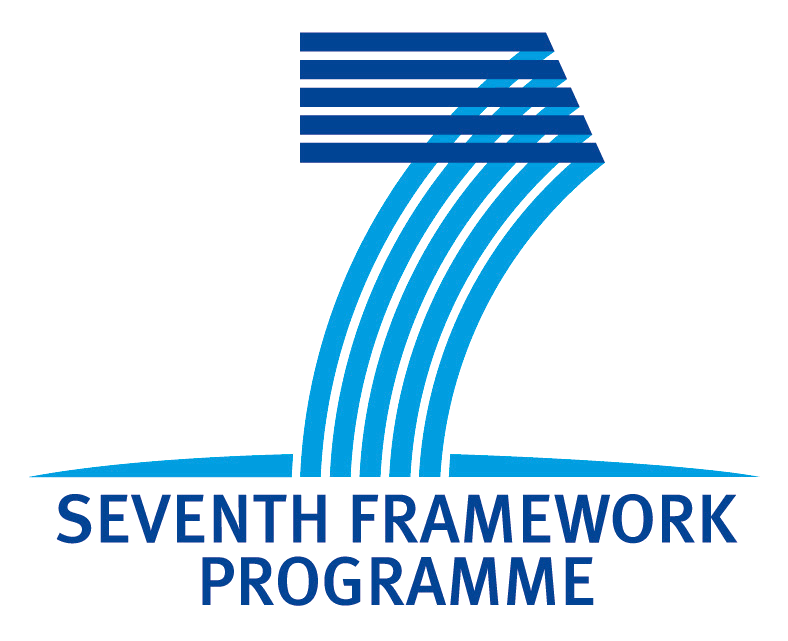Mathematics flagship (preliminar)
Mathematics flagship
Mathematical Grammar Library
Contributors: Jordi Saludes, Ares Ribó, Sebastian Xambó, Olga Caprotti, Aarne Ranta, Krasimir Angelov, Ramona Enach, Adam Slaski, Thomas Hallgren, Shafqat Mumtaz Virk
.notes: Contributors for Fre, Rus?
Goal:
To provide mathematics in natural language in many natural languages.
Including interfacing with math software.
Cloud services for mathematics
Contributors: Kaarel Kaljurand, Thomas Hallgren, Aarne Ranta, Jordi Saludes
The cloud services for mathematics provide linearization and parsing of mathematical text in many languages, as supported by the Mathematical Grammar Library.
Multilingual semantic wiki on mathematics
Exploitation scenarios: e.g. a browser plugin that, upon highlighting, translates the mathematical text, sends it to a computational engine, prompts the user for some decision, explains some symbol, searches in a mathematically meaningful way.
Multilingual semantic wiki
Contributors: Kaarel Kaljurand, Olga Caprotti, Jordi Saludes, Aarne Ranta, Ares Ribó
Running on ACE wiki here.
Mixed formula/natural lenguage rendering of mathematics.
Support for qualified variables in quantifiers:
- for all prime natural numbers n and m, ...
Aimed at expressing theorem statements and exercises.
Features
A predictive parser allows a contributor to construct a well-formed statement or exercise.
In English, Italian or Spanish.
Automatically rendered in the reader language.
A contributor is aware of ambiguous interpretations.
Example
- Translations

Ambiguities
- Let x be a prime number. Then for all integer numbers y and z, if x divides the product of y and z then x divides y or x divides z.
- It has 3 different meanings. The wiki shows the tree structure of all of them.
Multi-modal input/output of mathematics
Contributors: Ares Ribó, Jordi Saludes, Sebastian Xambó
Goal: Querying a Computer Algebra System by natural language.
.notes: This is also shown in the Query technologies flagship
Interfacing Sage
A command line tool for computing using natural language and aural replies.
An embedded interface in the Sage notebook. Using natural language in a Sage cell by prefixing it with expressions like
%english.
Sage interface workflow
Word problem solver dialog system
Contributors: Ares Ribó, Olga Caprotti, Thomas Hallgren, Aarne Ranta, Jordi Saludes
Tools for:
Writing a problem.
Workflow
Word problem schemata
The current prototype allows to state word problems of the following form:
Human (has or owns) (numeral or some) class
how many class does Human (have or own)?
where class is: animals, rabbits, cows, fruits, apples, etc. and Human: John or Mary.
in the languages: English, Swedish, Spanish and Catalan.
Classes and objects can be extended by adding entries to the
WPEntitiesmodule.
Setting the problem model
We considered two levels of discourse:
The plain language is for direct communication with the user, natural language;
The core language is for the reasoner to work with.
The fact that John has seven fruit is represented by the GF tree:
fromProp (E1owns john (gen Fruit n7))
and in Prolog by:
own(john, 7 * fruit)
while in core, it converts to the Prolog assertion:
p(X, fruit, own(john, X)) - 7 * unit(fruit)).
The latter is more suited to reasoning with it.
Normalization
Conjunctions are disaggregated: namely
- John has three apples and six bananas
is converted into:
- John has three apples
- John has six bananas
Questions make the unknown explicit in the core expressions:
- how many apples does Mary have?
is represented in plain as:
find(own(mary,apple))
and in core as:
find(X, apple, own(mary,X))
Example
% abs:fromProp (E1owns john (gen Fruit n7))
% Eng:John has seven fruit .
p(X, fruit, own(john, X)) - 7 * unit(fruit).
% abs:fromProp (E1owns john (aplus (ConsAmount (gen Apple n2)
% (BaseAmount (some Orange) (gen Banana n3)))))
% Eng:John has two apples , some oranges and three bananas .
p(Y, apple, own(john, Y)) - 2 * unit(apple).
p(Z, banana, own(john, Z)) - 3 * unit(banana).
p(V, orange, own(john, V)) - some(orange).
% abs:fromQuestion (Q1owns john Orange)
% Eng:how many oranges does John have ?
find(W, orange, own(john, W)).
Solving a problem
To process a given word problem, the student must construct a set of of statements in core language that model that given word problem.
The authoring interpreter saves a word problem in a Prolog file consisting of:
A GF abstract tree for the plain sentence of a problem. This is written as a Prolog comment.
Core statements in Prolog format that correspond to the plain expression.
Modeling a problem
When the dialog interpreter is started on a word problem file, the system uses the GF abstract lines to display the statement of the problem in the selected language.
Next, the student must go through a sequence of steps to have the problem correctly modeled by:
assigning variables to given data and to unknowns
discovering relations among the given data
stating equations involving these unknowns
Steps 1 and 2
Assigning variables
At the beginnig the student must choose variables to designate unknowns that are relevant to the problem.
This includes the target unknowns (they appear as arguments of
findclauses) and expressions like some apples.Discovering relations
In this step the student has to combine information from different statements into new relations.
For example, decomposing the fruits that John has into the apples and bananas that John has.
Steps 3 and 4
Stating equations
In the next step, the student converts the relations uncovered in the previous step into numerical equations.
This step finishes when there are enough equations to determine the unknowns of the problem.
The system checks that the student's equations are consistent equations and are entailed by the problem information.
Final
At the last step, the system displays the solution for the unknowns of the problem and exits.
| Attachment | Size |
|---|---|
| sage-wf.pdf | 28.17 KB |
| wproblems-wf.pdf | 54.2 KB |
| wiki-translations.png | 34.37 KB |
- Printer-friendly version
- Login to post comments
- Slides
What links here
No backlinks found.


